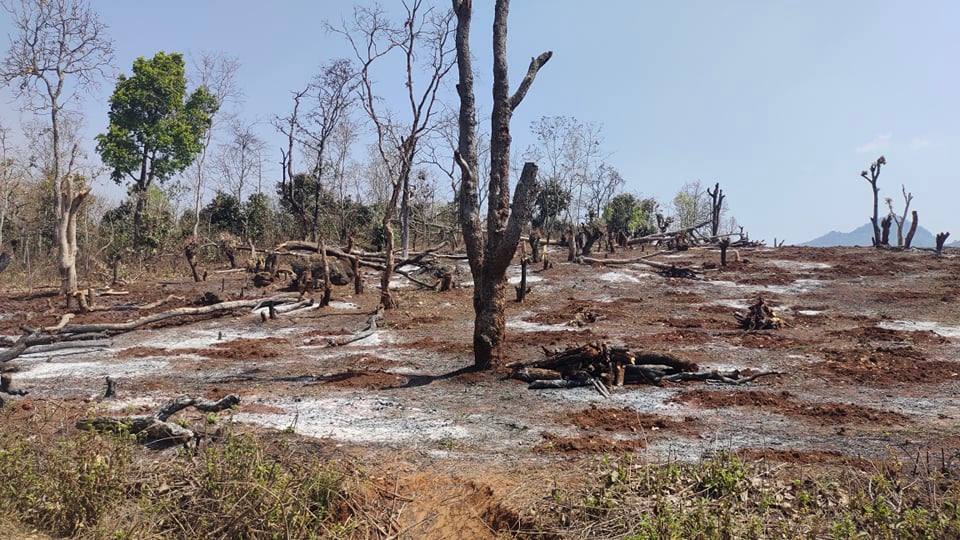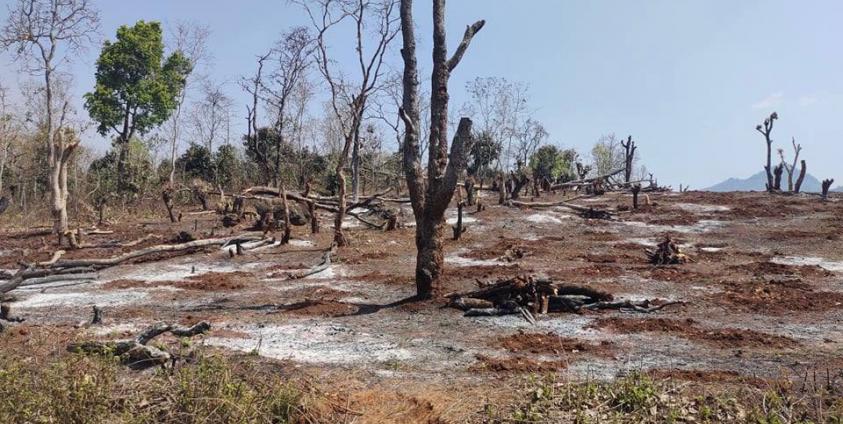It is about dawn when everyone is bringing their offerings and heading to the shrine, where the natives are regarded as a source of water, to pray and submit their offerings.
Along the way, the natives are chatting about their next year plan for their agriculture farming while walking at a fast pace to the shrine.
That shrine is located in Mongnai city, and it is the belief of the locals that every year during Ga Sone Full Moon (in April or May), they would submit offerings to that shrine in order to have an abundance of water for use and for farming.
Even though the locals are doing the ritual every year, the locals started experiencing drought in Mongnai township, Southern Shan State, where water sources are plentiful.
“The water sources are drying this year. We have never experienced such a shortage of water in the past years,” Sai Mg Gyi who lives in Mongnai told SHAN.
Brief History of Mongnai City
Mongnai township is a small city situated in Langkho district, Southern Shan State, and it is famous for its historical stupas and pagodas, caves, and other historic cultural heritages.
As the city is surrounded by many stupas and pagodas and other cultural heritage, it is known as the second Bagan (Shan Bagan).

Mongnai city was ruled and developed by traditional monarchies or fiefdoms called Sao Pha from generation to generation as First Mongnai, Second Mongnai, and Third Mongnai. First Mongnai city was built 19 miles northeast of the current city, and Second Mongnai was developed 4 miles east of the current city respectively.
The Third Mongnai was established by a Mongnai’s Sao Pha, Sao Pate Hom Pha, during the era of King Bayin Naung in 1557. Even though Mongnai Sao Pha submitted to King Bayin Naung, his son Nyaung Yan Min invaded Mongnai in 1603, and Mongnai fell into the reign of a Myanmar king.
The two lotus-shaped brick wall at the entrance of Mongnai is the most well-known symbol of the city. Once passing through that, one would feel the cultural heritage spirit of the city.
Among many other attractive things are the lotus bud shaped city wall entrance, Loi Lem monastery, historic pagodas and stupas, caves, Mongnai palace, and many other historic cultural heritage sites.
Moreover, the bronze cattle shape statue is another famous historic symbol of Mongnai. The bronze cattle statue was given as a gift by a Keng Tung Sao Pha when he came to visit Mongnai that time.
A beacon which was built during the Sao Pha ruling era is still existing and intact.
“The cultural heritages are still existing until today. The beacon built during the Sao Pha ruling era is still strong and intact. The bronze cattle statue is still kept here. Mongnai city is full of historical legacies. It was really good to live during the Sao Pha ruling era,” one of the Mongnai Sao Pha’s sons, Sao Hseng Mong, told SHAN.
Environmental Lost
Mongnai is surrounded by mountains and forests which makes the region full of water resources and successful in agricultural farming.
Even though water was plentiful for both drinking and farming in the past in Mongnai, it has become an issue for the residents starting this year.
Mongnai is mainly relying on natural water sources – from streams, ponds, underground water, etc. The most used sources are Nam Hu Set Thaw, Nam Nong Long, Nong U Yin, Nam Ton, and Nam Thein river.
Natives use the water stream flowing from Nam Hu Set Thaw to Nam Ton for agricultural farming and Nam Nong Long and Nong U Yin are used for drinking water.
In the past, the surrounding mountains covered with green forest and water were plentiful; however, water is now scarce due to the deforestation. During summer, the temperature increases and water dries out.
“It is very hot this year, hotter than every past year. Water is also dried in many places. The number of trees is also much less than before,” Long Mg, a farmer, told SHAN.
The high temperature and drought are the consequences of the deforestation, and farmers cleared more forests to farm corn which has the market potential these days.
The natives are cutting trees in Mongnai for various reasons while companies are cutting trees for commercial purposes.
The logging is not only happening in Mongnai but also in Langkho, Mawkmai, and Keng Tong townships.
“Farmers are cutting trees for the expansion of farmland. Some came with a 20-wheel big truck to transport the logs, and we do not know which group or organization they belong to,” a young activist who lives in Mongnai told SHAN.
The Consequences
Due to the deforestation, Mongnai is now facing a drought which has never happened before.
“During the past years, we have never faced and been concerned about the water shortage issue. But we have seen it now. It is the consequences of deforestation,” the 25 years old Sai Pha told SHAN.
Sai Pha also added that logging has been done since 2008 to 2020, and now there are no more trees to cut down.
Currently, as the corn demand is high and profitable, farmers are clearing more forests for the farmland to grow corn.
Additionally, since the electricity blackout is common these days, the natives are relying more on the firewood which led to cutting more trees.
“The natives are also expanding their farmland by cutting down more trees. Right now farmers are growing corn. If there is not enough land, more trees are cut to grow corn. Moreover, electricity is not reliable these days, so people are turning to using firewood,” Sai Pha continued, telling the current issue in Mongnai.
The natives expressed their concerns that about 70 percent of the forest is gone in Mongnai currently.
Because of that, shortage of water is the consequence of deforestation, and farmers are not having adequate water to grow crops now.
There are a lot of difficulties for the farmers to grow paddy this year – they are worried that they will not be able to grow paddy because of the drought. Some can no longer irrigate water to their farm this year.
“I am not sure if we will be able to grow paddy this year. Due to the drought, we can no longer irrigate water to our farms. If there is no water, there is no way we can grow paddy. Our only hope is the rain water,” a farmer, Long Mg, told SHAN.
After the coup, the political instability and Covid-19 pandemic have caused the spike in inflation; moreover, the electricity blackout is another additional pressing issue.
As the commodity price is going up, it is also affecting farmers because the price of the paddy seed is also increasing.
Apart from that, the high fuel price has made it difficult for the farmers to pump water into their fields.
“We can pump water into our field using a water pump. But to use the machine, we need gasoline. The price of gasoline is very high. Also, the price of the paddy seed is very high. Therefore, it is no longer profitable – we cannot even cover the labor cost,” Long Mg told SHAN.
In the past, there were also many coal mining projects in Mongnai, and their operations have been suspended recently. The locals are worried that those coal mining projects will resume one day.
Even though Mongnai residents have been praying to have plenty of water and to have a fruitful harvest, their prayer has not been answered because of the recent drought.







